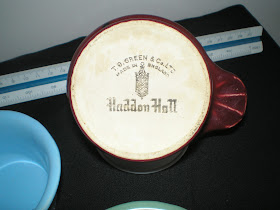Not Australian , but if it wasn't for Australian money back in the gold rush days, they may not have been made. More accurately described as a single serve dish for butter or jam, these small ramekins were made by the T. G. Green Potteries, located in the town of Church Gresley near Swadlincote, Derbyshire famous for its Cornishware and Domino brands. They are stamped “Haddon Hall”, a medieval manor house and now home of the Manners family, the Dukes of Rutland. Bakewell, Derbyshire Peak District. Formerly the home of the Vernons, it is located in the Peak District by the River Wye near Bakewell, Derbyshire. Minton and Johnson potteries also produced ranges named “Haddon Hall”.
There were ten potteries were in operation in and around Church Gresley in the 19th Century. This pottery was originally set up by a Mr. Leedham in the 1790s and continued by William and Joseph Bourne, it was then bought by Henry Wileman in 1851. The pottery was then sold by Henry to Thomas Goodwin Green in 1864.
Thomas Goodwin Green had been a sucessful builder in Austraila but when he heard his childhood sweetheart was prepared to reconcider marrage he retuned to Britain and sucessfully pursued her. Whilst on honeymoon in 1864 at Scarborough he met Henry Wileman the owner of a small pottery in the Derbyshire village of Church Gresley. Mr Wileman was getting old and was looking to sell his pottery and retire. Thomas used the money from the sale of his Australian business to purchase the pottery,
Church Gresley was named from 'Gresele', the original spelling of a grassy clearing on top of a hill, surrounded by forest, at the village's creation in 1086, not to be confused with the German company of Grizelle. Church Gresley is a village and former civil parish in the South Derbyshire district of Derbyshire, England. The village is very close to the town of Swadlincote, and between Swadlincote and Castle Gresley. According to the 2001 census the parish had a population of 4,805. Church Gresley and Castle Gresley are both parts of the region known as Gresley.
Their pottery was located about 35 miles from Stoke on Trent, the centre of pottery making in the U.K. The factory relied on self-sufficiency by employing an entire workforce to produce its own brick clay, extracting coal from its own land and operating a lime-kiln built to manufacture its own lime mortar. As well as the labour employed in the milling of raw materials, craftsmen such as carpenters and blacksmiths were employed to help making stilts, glazes and kiln furniture. As the business grew, Thomas formed a partnership with Henry William King and the company remained in the hands of the Green and King families until 1965.
The pottery then went into administration. They were bought out by a London based finacier in 1967 who sold it on the following year to Mr Pat H Freeman who continued to run the business producing its trade mark blue and white Cornishware.
Greens were later bought out by Mason, Cash & Co. who were established in 1901 by Thomas Cash who retained the 'Mason' name of the previous owner. The business was incorporated as Mason, Cash & Co. Ltd in 1941 and continued to produce its utilitarian wares throughout the Second World War. The share capital of the company was purchased by A. B. Merriam in 1973 and in February 1986 the company acquired Cauldon Potteries Ltd and the rights to the 'Royal Cauldon' name from T. Brown & Son Ltd. of the Ferrybridge Pottery at Knottingly, Yorkshire.
In 2001 the company purchased T. G. Green & Co. Ltd, but by 2004 it faced receivership and in April 2004 Mason Cash & Co. Ltd (including T. G. Green & Co. Ltd) were purchased by The Tabletop Company forming the ‘Tabletop Group’. Both Mason Cash and T. G. Green continued to operate under their own names within the Group.



No comments:
Post a Comment